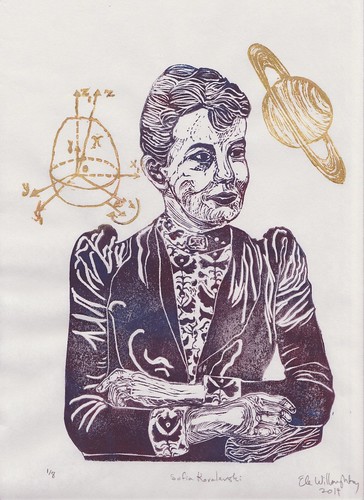 |
| 'Sofia Kovalevski', linocut 9.25" by 12.5" (23.5 cm by 32 cm), 2014 by Ele Willoughby |
Also known as Sofie or Sonya, her last name has been transliterated from the Cyrillic Со́фья Васи́льевна Ковале́вска in a variety of ways, including Kovalevskaya and Kowalevski. Sofia's contributions to analysis, differential equations and mechanics include the Cauchy-Kovalevski theorem and the famed Kovalevski top (well, famed in certain circles, no pun intended). She was the first woman appointed to a full professorship in Northern Europe or to serve as editor of a major scientific journal. She is also remembered for her contributions to Russian literature. All of this despite living when women were still barred from attending university. Her accomplishments were tremendous in her short but astonishing life.
Born Sofia Korvin-Krukovskaya, in Moscow, the second of three children, she attributed her early aptitude for calculus to a shortage of wallpaper, which lead her father to have the nursery papered with his old differential and integral analysis notes. Her parents nurtured her early interest in math, and hired her a tutor. The local priest's son introduced her to nihilism. So both her bent for revolutionary politics and passion for math were established early.
Unable to continue her education in Russia, like many of her fellow modern, young women including her sister, she sought a marriage of convenience. Women were both unable to study at university or leave the country without permission of their father or husband. Men sympathetic to their plight would participate in "fictitious marriages" to allow them an opportunity to seek further education abroad. She married the young paleontology student, Vladimir Kovalevsky, later famous for his collaboration with Charles Darwin. They emigrated in 1867, and by 1869 she enrolled in the German University of Heidelburg, where she could at least audit classes with the professors' permission. She studied with such luminaries as Helmholtz, Kirchhoff and Bunsen. She moved to Berlin and studied privately with Weierstrass, as women could not even audit classes there. In 1874, she present three papers, on partial differential equations, on the dynamics of Saturn's rings (as illustrated in my linocut) and on elliptic integrals as a doctoral dissertation at the University of of Göttingen. Weierstrass campaigned to allow her to defend her doctorate without usual required lectures and examinations, arguing that each of these papers warranted a doctorate, and she graduated summa cum laude - the first woman in Germany to do so.
She and her husband counted amongst their friends the great intellectuals of the day including Fyodor Dosteyevsky (who had been engaged to her sister Ann), Thomas Huxley, Charles Darwin, Herbert Spencer, and George Elliot. The sentence "In short, woman was a problem which, since Mr. Brooke's mind felt blank before it, could hardly be less complicated than the revolutions of an irregular solid." from Elliot's Middlemarch, is undoubtedly due to her friendship with Kovaleski. Sofia and Vladimir believed in ideas of utopian socialism and traveled to Paris to help those the injured from the Paris Commune and help rescue Sofia's brother-in-law, Ann's husband Victor Jaclard.
In the 1880s, Sofia and her husband had financial difficulties and a complex relationship. As a woman Sofia was prevented from lecturing in mathematics, even as a volunteer. Vladimir tried working in business and then house building, with Sofia's assistance, to remain solvent. They were unsuccessful and went bankrupt. They reestablished themselves when Vladimir secured a job. Sofia occupied herself helping her neighbours to electrify street lamps. They tried returning to Russia, where their political beliefs interfered with any chance to obtain professorships. They moved on to Germany, where Vladimir's mental health suffered and they were often separated. Then, for several years, they lived a real marriage, rather than one of convenience, and they conceived their daughter Sofia, called Fufa. When Fufa turned one, Sofia entrusted her to her sister so she could return to mathematics, leaving Vladimir behind. By 1883, he faced increasing mood swings and the threat of prosecution for his role in a stock swindle. He took his own life.
Mathematician Gösta Mittag-Leffler, a fellow student of Weierstrass, helped Sofia secure a position as a privat-docent at Stockholm University in Sweden. She developed an intimate "romantic friendship" with his sister, actress, novelist, and playwright Duchess Anne-Charlotte Edgren-Leffler, with whom she collaborated in works of literature, for the remainder of her too short life. In 1884 she was appointed "Professor Extraordinarius" (Professor without Chair) and became the editor of the journal Acta Mathematica. She won the Prix Bordin of the French Academy of Science, for her work on the rotation of irregular solids about a fixed point (as illustrated by the diagram in my linocut) including the discovery of the celebrated "Kovalevsky top". We now know there are only three fully integrable cases of rigid body motion and her solution ranks with those of mathematical luminaries Euler and Lagrange. In 1889, she was promoted to Professor Ordinarius (Professorial Chair holder) becoming the first woman to hold such a position at a northern European university. Though she never secured a Russian professorship, the Russian Academy of Sciences granted her a Chair, after much lobbying and rule-changing on her behalf.
Her writings include the memoir A Russian Childhood, plays written in collaboration with Edgren-Leffler, and the semi-autobiographical novel Nihilist Girl (1890).
Tragically, she died at 41, of influenza during the pandemic. Prizes, lectures and a moon crater have been named in her honour. She appears in film and fiction, including Nobel laureate Alice Munro's beautiful novella 'Too Much Happiness', a title taken from Sofia's own writing about her life.






No comments:
Post a Comment